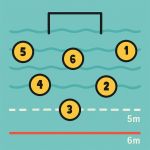The horseshoe is a structured offensive setup used to space attackers between the 2 m and 6 m lines, open passing angles, and create high-percentage entries to the center forward. In Canada, coaches use a numbering system (1–6) to refer to positions in this shape. These numbers identify roles and spots in the water and do not relate to cap numbers.
Why number and name the positions?
- Fast, clear communication: Calls like “swing to 2” or “look for 6” are unambiguous in a noisy pool.
- Role clarity: Names (Wing, Driver/Flat, Point, Hole Set) tell players what options they have from each spot.
- Rotational understanding: As players cycle through spots, a shared language preserves structure.
- Consistency across levels: Common terminology helps athletes transition between teams and age groups.
Roles in the Horseshoe (Canadian Numbering)
- 1 – Right Wing
- Wide near 2 m on the right. Feeds the center, threatens cross-cage shots, and initiates inside drives. Left-handers here are especially dangerous.
- 2 – Right Driver / Flat
- Above the wing. Balances outside shooting, ball movement, and hard drives to shift defenders.
- 3 – Point
- Top of the formation. Directs traffic, swings the ball, initiates rotations, and shoots when the defense sags.
- 4 – Left Driver / Flat
- Mirror of 2. Creates movement, keeps the weak side active, and punishes overplays with drives or outside shots.
- 5 – Left Wing
- Wide near 2 m on the left. Prime angle to feed center, threatens cross-cage shots, and initiates inside drives.
- 6 – Center Forward / Hole Set
- Anchor just above 2 m, directly in front of goal. Fights for position, receives entries, draws exclusions, and finishes.
Reminder: Position numbers (1–6) are tactical labels and not a player’s cap number.
Drills you can run from the Horseshoe
- Perimeter Ball Swing
- Pass 1 → 2 → 3 → 4 → 5 and back; maintain spacing and passing rhythm.
- Variation: Add a pressing defender on the ball.
- Entry to 6 Timing
- Work the ball until 6 has inside water; deliver a crisp wet pass.
- Progression: On an exclusion, flow straight into a 6-on-5.
- Driver/Flat Initiated Drive
- From 2 or 4, hard drive to the middle; teammates read and react—feed the drive or swing opposite.
- Teaches recognition and creates dynamic movement against static defenses.
- Point Decision Reset
- Ball arrives to 3; options are immediate shot, swing, or call a drive.
- Builds decision-making and game management from the top.
- Quick-Shoot Wings
- Rapid catch-and-shoot reps for 1 and 5 to keep perimeter threats honest.
- Variation: Add a shot fake then release; alternate corners.
Why this helps coaching
- Teachable structure: Clear lanes and roles make feedback specific and repeatable.
- Skill layering: The same shape supports passing, shooting, driving, and entry timing progressions.
- Game transfer: Athletes recognize spacing cues and read-and-react patterns from practice to matches.
- Shared vocabulary: A common language improves sub-ins, rotations, and mid-game adjustments.
Bottom line: The horseshoe is a reliable offensive platform that balances perimeter spacing with an interior threat. Numbering (1–6) and role names give everyone the same map—so play calls are clearer, decisions are faster, and finishes are better.



